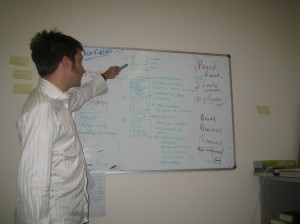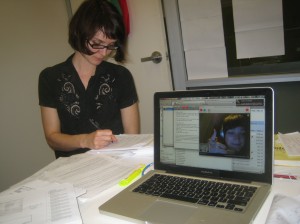Huge meeting last Thursday with DAAO core team (Jo, Olivia and me) and the House of Laudanum team ( Zina, Snow and Lotte (who skyped in from Amsterdam).

Snow talking us through some of the ways we can automate data entry making the task less onerous and more accurate.
We talked a lot about the contributor- that is the person who will write accurate quality biographies and enter accurate relevant data in the metadata fields. When we extend the schema- we are also asking people to enter in more data- to make a greater commitment to the DAAO. We have to make it worth their while. We can think of this extra value along two different paths: the satisfaction one gets at interacting with good design and seeing a change being made to a record in real-time; and the additional value one gets from being part of a community that is relevant and useful to you. In the image above, Snow is talking us through how a semi- automated data entry system could help ease the burden of data entry on the contributor. For instance, imagine if you could just cut and paste an exhibitions list into one field, rather than entering every exhibition into a single field? Too much data entry is placing a big obstacle to to contributing to the DAAO. However, each decision we make has consequences.
If we allow cutting and pasting exhibitions into one field-how will that affect exhibition search results? Could we find a system that structures the data automatically? For instance, we are thinking about using Open Calais to help use semantically structure the biography text fields so that much of the metadata fields can be automatically populated from the biography text. Using semantic web technologies (which is important in terms of future proofing our site) also has implications for the structure of our database.

Only one week back and Olivia is as focused as ever. Lotte on the lap top is holding up well, given that it is 10pm Amsterdam time.
There are always compromises made in the design process- who we do focus on- the contributor ( the person who produces, checks and updates the content) or the user? Of course, ideally they would overlap considerably (think social media)- but our research shows that they are pretty disparate groups at the moment- which is why ‘community building’ is so pivotal in projects like this. At this stage, we need to think a lot about the experience of getting content onto the site as we need more content- and it needs to be authorative, up-to date and comprehensive. There is no user without a contributor.
There is lots to do, but the DAAO is in many ways still in its infancy- we can plan for the future, by making priority lists. This process is sometimes called MoSCoW- Must-Should-Could-Want. Because we are developing the project in a modular fashion, we can assign some things as CANs and WANTS and develop them later and write new grants to develop them with different partners. For instance, it would be brilliant to have a ‘save search and annotate’ feature in this iteration of the DAAO, but can we afford it? Is it the most important thing now? or would we rather try and get images into the site? (User research says Images gets Must, Save search and annotate gets a Could). All of these features that we want go into the technical specification which we hand over to the Developer and we work with them to get as far down our priority list as we can without compromising the quality and functionality of the site.
More soon!
